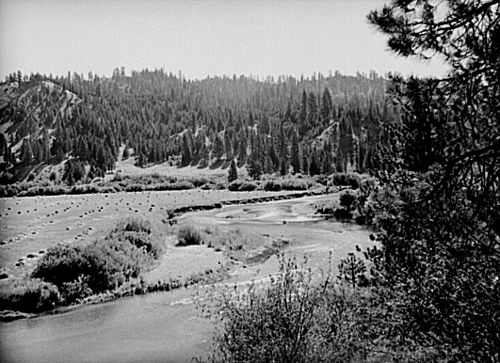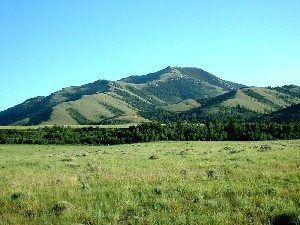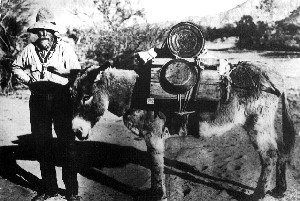Bannock County – In 1865, 300 pounds of gold were stolen during a stagecoach robbery. The bandits were said to have buried the loot about ¾ mile north of McCammon at a spot now called Robber’s Roost. With the posse hot on their trail, the robbers fled but were quickly found, and in the ensuing gunfight, they were killed. The stolen gold has never been recovered.

Boise County, Idaho
Boise County – Close to 3,000,000 troy ounces of gold have been removed from the gravels of the Bose Basin, and according to treasure hunters, there is plenty more to be found. Hotspots would include the many watercourses through the area and gravel arroyos northeast of Boise, near Idaho City.
Boise County – Near the Nevada state line at Rye Flats, a shipment of newly-minted gold coins, still in their original wrappers, is said to have been hidden in a metal box. Inside an above-ground cave, the coins were worth $40,000 when stolen. Allegedly, the bandits never returned for the stolen loot.
Bonner County – In 1888, after successfully prospecting in the area of Priest Lake, a prospector named Zak Stoneman was headed to cash in his gold when his mules died after eating poisoned weeds. Burying three burro loads of gold in the area north of the Priest River and 3-4 miles below Priest Lake, he continued his journey. However, when he returned to recover his buried cache, he could never find the correct location. According to the legend, it is still buried somewhere in this area.

Deep Creek Peak, Idaho
Cassia County – In the 1890s, a range war erupted between cattlemen and sheepherders in the vast lands of Cassia County. Not to be deterred, the richer cattlemen brought in hired gunslingers, including Jackson Lee Davis, better known as Diamondfield Jack. Before it was over, two sheepherders had been shot, and Diamondfield Jack was sentenced to hang for murder. Later a man named James E. Bower confessed to the killing, and Jack was let go, moving on to Nevada, where he made his fortune in gold mining. Today, it is said that during the range war, cattlemen and sheepherders cached their valuables around Deep Creek and Shoshone Creek.
Custer County – Near the mouth of the Yankee Fork River, Isaac T. Swim discovered gold-bearing quartz in the late summer of 1881. He quickly went to Challis, the Custer County seat, to file a claim. He returned to his claim to take some samples in the Fall but didn’t stay long as winter quickly set in. The following June, he and several other miners set out for the quartz cropping. However, when they came upon the Salmon River, they found it running extremely high from the spring run-off. Though Swim thought they should wait until the river had tamed down a little, the other miners were impatient. Swim then agreed to cross first and then return for the other men. When he didn’t come back, the other miners began to search for him and soon found his drowned horse a short distance downstream. Swim’s body was found later in the summer. He had died with the specific location of the rich quartz with him. Though his partners tried to find the gold, and one did find a claim marker across the river from the mouth of the Yankee Fork, the gold was never found.
Idaho County – About five miles southwest of White Bird, along the Salmon River, is called Robber’s Gulch. Over a century ago, outlaws held up a freight wagon carrying about $75,000 in miners’ gold and hid it among the rocks before heading toward the rough Seven Devils area. But the unlucky robbers would not live to return for their stolen cache, as a posse caught up with them in the mountains, and every last one was shot before anyone thought to ask about the whereabouts of the stolen loot. To date, the gold has never been found.

Idaho prospector
Kootenai County – In November 1889, a prospector named Jack Breen found gold near Coeur D’Alene. Breen, however, didn’t have the funds to work the claim, so he soon went into Coeur D’Alene to find someone to grubstake him. Two men named N. R. Palmeter and Jack Osier agreed to be his partners, but Breen did not reveal the exact location, only that it was somewhere near Hayden Lake. Breen then went to get a drink at a local saloon, and bragging about his find, several customers began to buy him more drinks, hoping that he would reveal the location of the gold. Fearing Breen would give away the information, they persuaded the local marshal to put him in jail for “his own protection.” This proved to be a “deadly” mistake, as early the following day, the jail caught on fire, and before Breen could be released, he died from smoke inhalation.
Lewis & Clark Trail – During 1805 and 1806, Lewis and Clark traveled through Idaho, documenting the territory and meeting with Native Americans along the trail. Along the way, they distributed some 55 Washington Season medals to the Indian Chiefs as peace offerings. Due to the lack of tools and artisans in this country, these medals were made in Birmingham, England. In July of 1798, some 326 medals were received by the presidency, each individually engraved in solid silver. Very rare and worth a fortune, only a few are accounted for today. Many believe several of these medals can be found along the Idaho expedition path through Lewiston, Spaulding, Orofino, and others.
Shoshone County – Around 1900, a bank was robbed in the Wallace-Kellogg area, and the bandits made off with some $80,000. Hiding out from the authorities overnight, they were said to have buried their cache somewhere in the four-mile stretch between Huettner and Post Falls. However, with the posse on their tails, they were captured the next morning. The authorities could not find the stolen loot, and presumably, the bandits were hanged. To this day, it has never been recovered.
Shoshone County – Butch Cassidy and his outlaw gang allegedly buried some of their loot north of the old stage road between Spokane Falls, Washington, and Wallace, Idaho. The cache was said to have been buried along a creek on the edge of a beaver dam.
Twin Falls County – In 1888, an outlaw acting alone robbed the Jarbidge-Idaho stage near the site of present-day Salmon Dam. The bandit was quickly overtaken and killed by a posse, but the gold was not found. Many believe the outlaw buried the strongbox on the east side of Brown’s Bench, a large flat mesa about 15 miles west of Rogerson, Idaho.
© Kathy Alexander/Legends of America, updated April 2023.
Also See:

